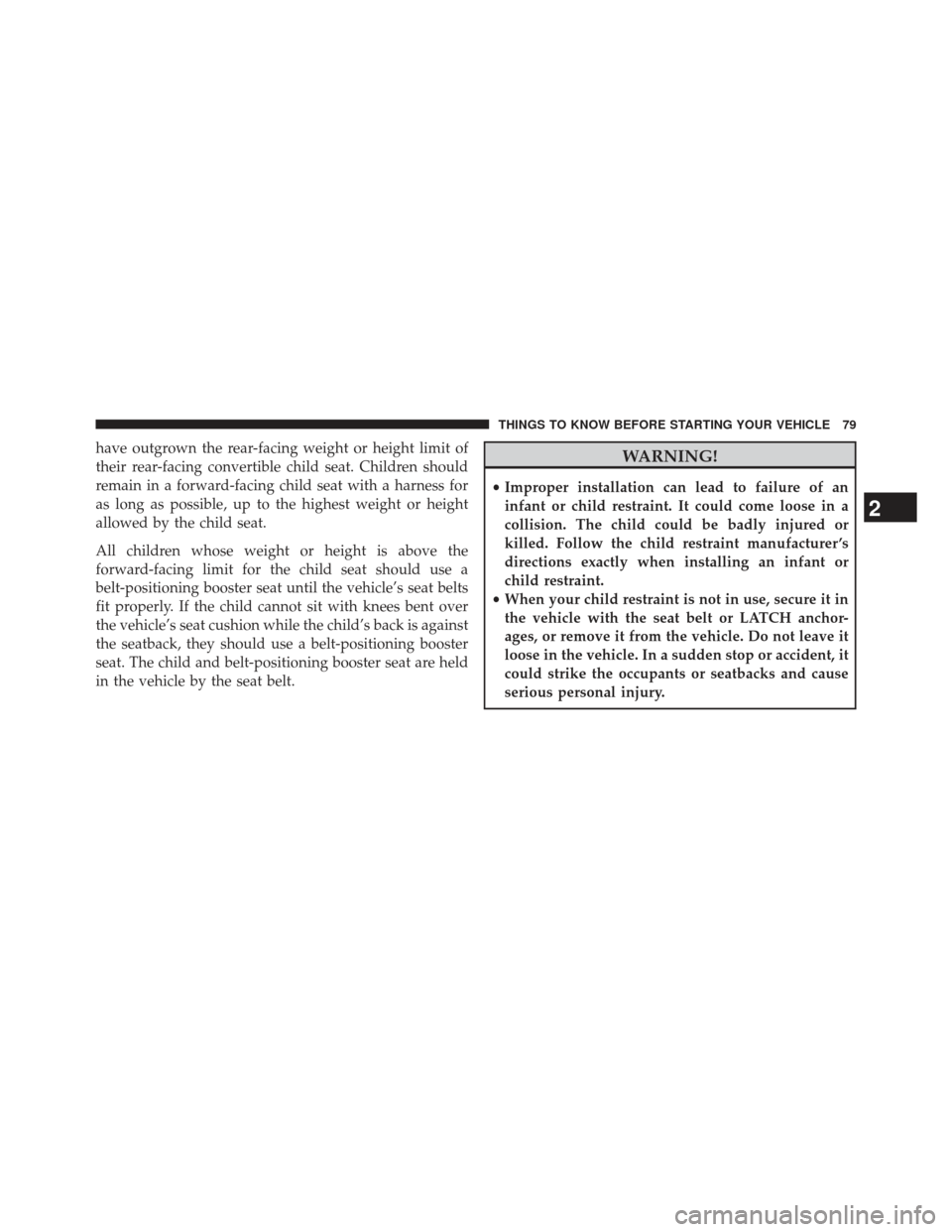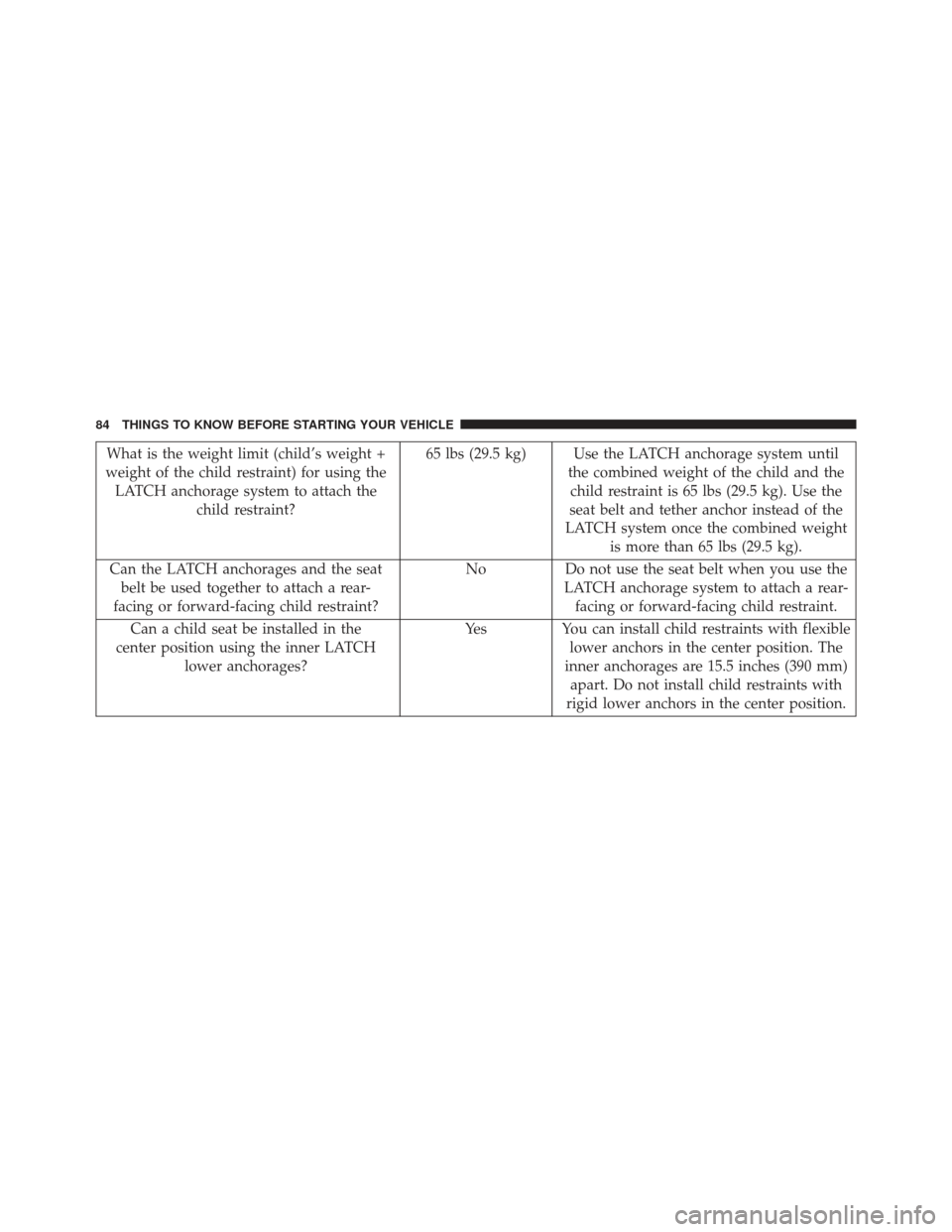Page 69 of 525

windows, or area where the SAB or SABIC air bags
inflate, even if they are in an infant or child restraint.
Always sit upright as possible with your back against the
seat back, use the seat belts properly, and use the
appropriate sized child restraint, infant restraint or
booster seat recommended for the size and weight of the
child.
Knee Impact Bolsters
The Knee Impact Bolster helps protect the knees of the
front passenger, and position the front occupant for the
best interaction with the Advanced Front Air Bag.
Along with seat belts and pretensioners, Advanced Front
Air Bags work with the bolsters to provide improved
protection for the driver and front passenger. Side air
bags also work with seat belts to improve occupant
protection.
Air Bag Deployment Sensors And Controls
Occupant Restraint Controller (ORC)
The ORC is part of a Federally regulated safety system
required for this vehicle.
The ORC determines if deployment of the front and/or
side air bags in a frontal or side collision is required.
Based on the impact sensor’s signals, a central electronic
ORC deploys the Advanced Front Air Bags, SABIC air
bags, Supplemental Seat-Mounted Side Air Bags — if
equipped, and front seat belt pretensioners, as required,
depending on several factors, including the severity and
type of impact.
Advanced Front Air Bags are designed to provide addi-
tional protection by supplementing the seat belts in
certain frontal collisions depending on several factors,2
THINGS TO KNOW BEFORE STARTING YOUR VEHICLE 67
Page 79 of 525

Summary Of Recommendations For Restraining Children In Vehicles
Child Size, Height, Weight or Age Recommended Type of Child Restraint
Infants and Toddlers Children who are two years old or
younger and who have not reached the
height or weight limits of their child
restraint Either an Infant Carrier or a Convertible
Child Restraint, facing rearward in the
rear seat of the vehicle
Small Children Children who are at least two years old
or who have out-grown the height or
weight limit of their rear-facing child
restraint Forward-Facing Child Restraint with a
five-point Harness, facing forward in
the rear seat of the vehicle
Larger Children Children who have out-grown their
forward-facing child restraint, but are
too small to properly fit the vehicle’s
seat belt Belt Positioning Booster Seat and the
vehicle seat belt, seated in the rear seat
of the vehicle
Children Too Large for
Child Restraints Children 12 years old or younger, who
have out-grown the height or weight
limit of their booster seat Vehicle Seat Belt, seated in the rear seat
of the vehicle
2
THINGS TO KNOW BEFORE STARTING YOUR VEHICLE 77
Page 80 of 525

Infants And Child Restraints
Safety experts recommend that children ride rearward-
facing in the vehicle until they are two years old or until
they reach either the height or weight limit of their rear
facing child safety seat. Two types of child restraints can
be used rearward-facing: infant carriers and convertible
child seats.
The infant carrier is only used rearward-facing in the
vehicle. It is recommended for children from birth until
they reach the weight or height limit of the infant carrier.
Convertible child seats can be used either rearward-
facing or forward-facing in the vehicle. Convertible child
seats often have a higher weight limit in the rearward-
facing direction than infant carriers do, so they can be
used rearward-facing by children who have outgrown
their infant carrier but are still less than at least two years
old. Children should remain rearward-facing until they
reach the highest weight or height allowed by their
convertible child seat.
WARNING!
•Never place a rear facing infant seat in front of an
air bag. A deploying passenger Advanced Front Air
Bag can cause death or serious injury to a child
12 years or younger, including a child in a rearward
facing infant seat.
• Only use a rearward-facing child restraint in a rear
seat.
Older Children And Child Restraints
Children who are two years old or who have outgrown
their rear-facing convertible child seat can ride forward-
facing in the vehicle. Forward-facing child seats and
convertible child seats used in the forward-facing direc-
tion are for children who are over two years old or who
78 THINGS TO KNOW BEFORE STARTING YOUR VEHICLE
Page 81 of 525

have outgrown the rear-facing weight or height limit of
their rear-facing convertible child seat. Children should
remain in a forward-facing child seat with a harness for
as long as possible, up to the highest weight or height
allowed by the child seat.
All children whose weight or height is above the
forward-facing limit for the child seat should use a
belt-positioning booster seat until the vehicle’s seat belts
fit properly. If the child cannot sit with knees bent over
the vehicle’s seat cushion while the child’s back is against
the seatback, they should use a belt-positioning booster
seat. The child and belt-positioning booster seat are held
in the vehicle by the seat belt.WARNING!
•Improper installation can lead to failure of an
infant or child restraint. It could come loose in a
collision. The child could be badly injured or
killed. Follow the child restraint manufacturer ’s
directions exactly when installing an infant or
child restraint.
• When your child restraint is not in use, secure it in
the vehicle with the seat belt or LATCH anchor-
ages, or remove it from the vehicle. Do not leave it
loose in the vehicle. In a sudden stop or accident, it
could strike the occupants or seatbacks and cause
serious personal injury.
2
THINGS TO KNOW BEFORE STARTING YOUR VEHICLE 79
Page 83 of 525
Recommendations For Attaching Child Restraints
Restraint Type CombinedWeight of the
Child + Child Restraint Use any attachment method shown with an “X” Below
LATCH –
Lower Anchors Only Seat Belt Only LATCH –
Lower Anchors+ Top Tether Anchor Seat Belt + Top
Tether Anchor
Rear-Facing
Child Restraint Up to 65 lbs
(29.5 kg) XX
Rear-Facing
Child Restraint More than
65 lbs (29.5 kg) X
Forward-Facing Child Restraint Up to 65 lbs
(29.5 kg) XX
Forward-Facing Child Restraint More than
65 lbs (29.5 kg) X
2
THINGS TO KNOW BEFORE STARTING YOUR VEHICLE 81
Page 86 of 525

What is the weight limit (child’s weight +
weight of the child restraint) for using the LATCH anchorage system to attach the child restraint? 65 lbs (29.5 kg) Use the LATCH anchorage system until
the combined weight of the child and thechild restraint is 65 lbs (29.5 kg). Use the
seat belt and tether anchor instead of the
LATCH system once the combined weight is more than 65 lbs (29.5 kg).
Can the LATCH anchorages and the seat belt be used together to attach a rear-
facing or forward-facing child restraint? No
Do not use the seat belt when you use the
LATCH anchorage system to attach a rear- facing or forward-facing child restraint.
Can a child seat be installed in the
center position using the inner LATCH lower anchorages? Yes
You can install child restraints with flexible
lower anchors in the center position. The
inner anchorages are 15.5 inches (390 mm) apart. Do not install child restraints with
rigid lower anchors in the center position.
84 THINGS TO KNOW BEFORE STARTING YOUR VEHICLE
Page 93 of 525
What is the weight limit (child’s
weight + weight of the child restraint)
for using the Tether Anchor with the
seat belt to attach a forward facing
child restraint?Weight limit of the Child Restraint Always use the tether anchor whenusing the seat belt to install a for-
ward facing child restraint, up to the
recommended weight limit of the
child restraint.
Can the rear-facing child restraint
touch the back of the front passenger
seat? Yes Contact between the front passenger
seat and the child restraint is al-
lowed, if the child restraint manu-
facturer also allows contact.
Can the head restraints be removed? No
Can the buckle stalk be twisted to
tighten the seat belt against the belt
path of the child restraint? Yes In positions with cinching latch
plates (CINCH), the buckle stalk
may be twisted up to 3 full turns. Do
not twist the buckle stalk in a seating
position with an ALR retractor.
2
THINGS TO KNOW BEFORE STARTING YOUR VEHICLE 91
Page 203 of 525
WARNING!
•Cargo tie-down loops are not safe anchors for a
child seat tether strap. In a sudden stop or collision
a loop could pull loose and allow the child seat to
come loose. A child could be badly injured. Use
only the anchors provided for child seat tethers.
• The weight and position of cargo and passengers
can change the vehicle center of gravity and vehicle
handling. To avoid loss of control resulting in
personal injury, follow these guidelines for loading
your vehicle:
• Always place cargo evenly on the cargo floor. Put
heavier objects as low and as far forward as pos-
sible.
(Continued)
Cargo Area Tie-Downs
3
UNDERSTANDING THE FEATURES OF YOUR VEHICLE 201